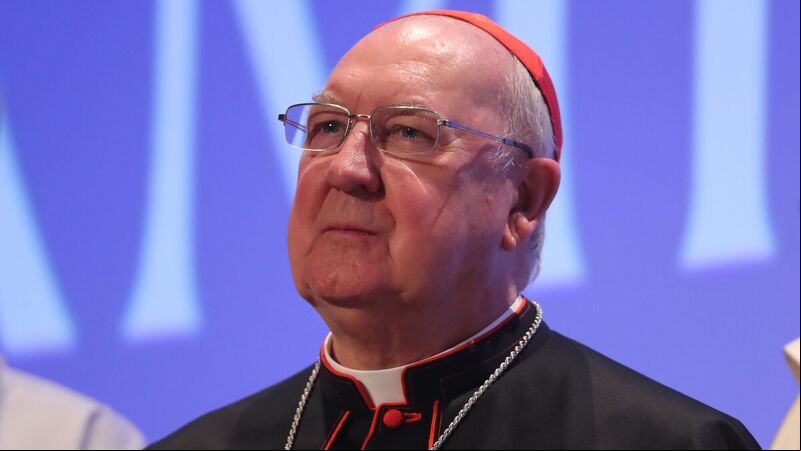Explainer: What happens in the lead up to a new pope being elected?

Cardinal Kevin Farrell who broke the news that Pope Francis had died.

Cardinal Kevin Farrell who broke the news that Pope Francis had died.
Early yesterday morning, the Vatican camerlengo, or chamberlain, Cardinal Kevin Farrell, broke the news that Pope Francis had died.
“At 7.35am [6.35am Irish time], the Bishop of Rome, Francis, returned to the Father’s house. His entire life was dedicated to the service of the Lord and his Church,” said Cardinal Farrell.
The pontiff, who was 88 and had been gravely ill for months, recently marked the 12th year of his papacy from his hospital bed.
Cardinal Farrell, who spent most of his clerical life in the US, will play a crucial role in the days and weeks that the Roman Catholic Church is without a pope, running the Church’s day-to-day business during the period known as the ‘sede vacante’ or ‘empty chair’.
The rituals marking the end of one papacy and the beginning of the next are mostly governed by a constitution known as universi dominici gregis (of the Lord’s whole flock), which was approved by Pope John Paul II and later revised by Pope Benedict XVI.
After the death of a pope, the camerlengo makes sure the pope’s ring and lead seal are destroyed, so nobody else may use them. No postmortem is performed.
It falls to the camerlengo to confirm the pope’s death, which involves a doctor and a death certificate, but until the last century, the pope was declared dead after being tapped three times on the forehead with a silver hammer.
The camerlengo and three assistants chosen from among cardinals under 80 years of age — known as cardinal electors — decide when the pope’s body is to be taken into St Peter’s Basilica for the public to pay their respects.
Pope Francis, who simplified many of the rituals around papal funerals, asked to be buried in a simple wooden casket, unlike his predecessors, who were buried in three interlocking caskets made of cypress, lead, and oak.
He also asked that his body not be put on display atop a raised platform, or catafalque, in St Peter’s Basilica, for viewing, as was the case with previous popes.
Conclave
The camerlengo assists the dean of the College of Cardinals to prepare the papal funeral and to organise the subsequent conclave, which will be held in the Sistine Chapel.
A conclave usually takes place 15 to 20 days after the death of a pope, and cardinals under the age of 80 are eligible to vote to elect the next pope.
Currently, there are 252 of the College of Cardinals, 138 of whom are under 80. Ireland’s only cardinal, former archbishop of Armagh Seán Brady, is 85 and is therefore ineligible to vote.
The cardinals will be locked away without communication with the outside world — the word conclave being from the Latin and meaning ‘with a key’ — in a tradition dating back more than 800 years.
Phones, internet, and newspapers are forbidden, and the Vatican police use electronic jamming devices to block signals from outside.
A majority of two-thirds plus one is needed for the election of a pope. If nobody is elected after 13 days, a run-off election is held between the two leading candidates, with a two-thirds plus one majority still needed.
Once the conclave has elected a pope, the victor is formally asked if he accepts the role, and which name he wishes to choose. If he decides to decline, the procedure begins again.
Upon election, and after he accepts, the new pope dons white vestments and sits on a throne in the Sistine Chapel, receiving the other cardinals, who pay homage to him and pledge their obedience.
In the outside world, the first sign that a new pope has been elected is the sight of white smoke billowing from the chimney of the Sistine Chapel.
This smoke is caused when an official burns the paper ballots, using a special chemical. Black smoke will show an inconclusive vote.
The senior elector among the cardinal deacons, currently Cardinal Dominique Mamberti, steps onto the central balcony of St Peter’s Basilica to announce to the crowds in the square: ‘Habemus Papam’: (‘We have a Pope’).
The new pope will then be announced by the camerlengo, Cardinal Farrell, and the new pontiff will then give the crowd his first papal blessing.
Keep up-to-date with the top stories in Cork with our daily newsletter straight to your inbox.
Please click here for our privacy statement.
9 minutes ago
Cork City Women crash out of the Avenir Sports All-Island Cup after defeat at Galwayan hour ago
Cork hurling fans kept the faith and this team delivered a Munster title victory for the ages59 seconds ago
'First stop will be Charleville!' - man of the match Darragh Fitzgibbon relishing Rebels' victory26 seconds ago
Former Cork TD and former trade unionist award-winning public relations firmHave you ed your FREE  App?
App?

It's all about Cork!
Add Echolive.ie to your home screen - easy access to Cork news, views, sport and more